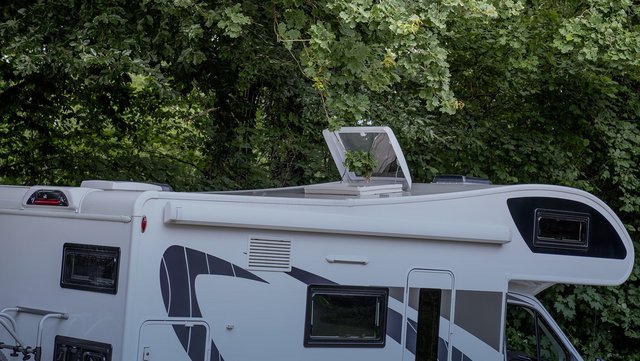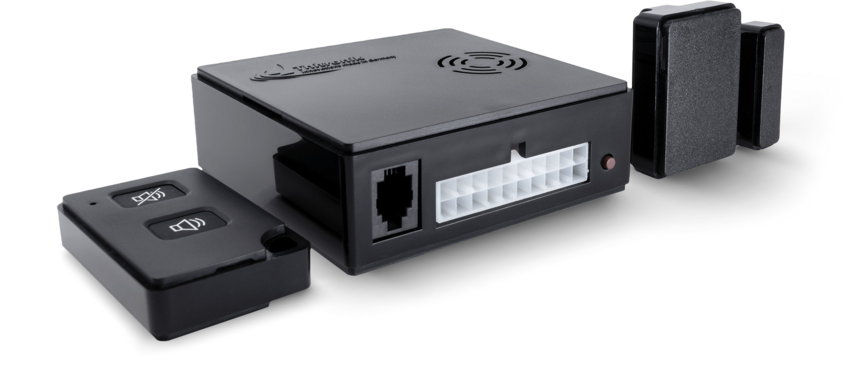
Completely protected
An alarm system only offers all-round protection if it can be enabled when people are inside. A small appeal to stop the nonsense of outdated motion detectors.
Let’s be honest. What do you expect of an alarm sys-tem in your motorhome or caravan? That it perfectly protects your vehicle and belongings when you’re not there? That’s absolutely fine. No objections to this high demand. But what if you are not there, but your dog is in the vehicle? You don’t have a dog? Alright – let’s take it one step further: you or your partner, children or grandchildren are in the vehicle! You are cooking, watching television or want to take a nap at noon or feel comfortable parked at a very isolated site at night.
Wouldn’t it be good if all storage compartment hatches, windows and doors were actively secured? We are certain: you would answer this question with a loud ‘Of course’. Which puts us in the middle of a heated discussion: how do motion detectors meet these demands? Or to be more specific: does it even make sense to have motion detectors as the central pillar of a security concept in leisure vehicles?
We at THITRONIK are convinced that the answer to this is ‘Absolutely not’.
A closer look at motion detectors

As the name suggests, motion detectors respond to motion and immediately trigger an alarm if they detect a motion. That’s a wonderful thing in your car – we agree. However, in a leisure vehicle other factors determine whether an alarm system should be used. As long as you are not there, the alarms could remain enabled. However, even if you leave a window or roof vent open to let air in, all it takes is a curtain fluttering in the wind to activate a motion sensor and thereby trigger a false alarm. You could lower the sensitivity of the sensors – fine, but by doing so you also lower the security level of the system.
Irritating factor: false alarms
And honestly: constant false alarms are very annoying – for you and your neighbours alike. But the weightiest argument against motion detectors remains: they offer no protection whatsoever when people are inside the vehicle – because they have to be disabled for this typical situation.
Once they are switched off, and only in higher-end systems, only the vehicle doors are secured, and possibly (if retrofitted at great effort and expense) the body door and one or two windows by wired sensors. Yet those are the laudable exceptions – and as already mentioned: installation of the wired sensors requires unnecessarily high investments. It can be done much more cheaply and elegantly – and securely besides. But we’ll get to that later.
However you look at it: the security concept of the motion detector for leisure vehicles remains patchy. Moreover, roof windows, side windows, rear garage and storage compartment hatches remain unsecured. An absolute absurdity, as we at THITRONIK see it. And you can be sure about one thing: if motion detectors would only optimise a single aspect of the THITRONIK security concept – we would be offering them to our customers tomorrow.
Right now we are certain – this aspect does not exist. And therefore we continue to rely on the coherent combination of an efficient alarm system, easy-to-add wireless sensors and a technically advanced GPS vehicle locating system. Trust us: in the development of all our products for lei-sure vehicles, your safety is our top priority.

Advantages and disadvantages of motion detectors and wireless magnetic contacts
Motion detectors
Advantages
- Detects intruders in the vehicle when the owner is away
- Secures the entire interior
- Cheap in terms of acquisition cost because only one device is required
Disadvantages
- Highly prone to false alarms
- Restricted freedom of movement of occupants of the vehicle with an enabled motion detector
- Must be disabled when campers present
- Limited protection with lowered sensitivity
- No protection of storage compartment hatches or rear garage
Wireless magnetic contacts
Advantages
- Easy no-drill installation
- Fast and inexpensive retrofitting with any number of contacts
- Wireless radio connection
- Individual control of all wireless magnetic contacts (airing function)
- Teach-in on the central control unit at any time
- Sabotage protection through a second sensitive reed contact
- Low battery early warning
- Simple operation
- Warning if windows are open when you are setting off (pre-departure check/vent-check)
Disadvantages
- Each relevant opening must be secured with a separate wireless magnet contact
- Higher acquisition cost because of multiple component
Thitronik Products
Further guide topics
-

Thitronik modules: a strong team
The THITRONIK modules are all strong players individ-ually. As a team, however, they make for an unbeat-able system.
-

Vent-check
A brief moment of carelessness: the damage can be enormous. Vent-check assumes for you a short check prior to departure. Comfortably, completely automatically.
-

easy add
Comfortable, fast teach-in of Thitronik components




